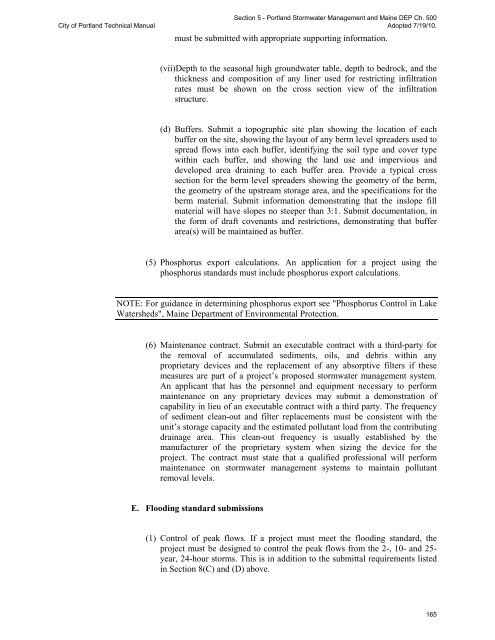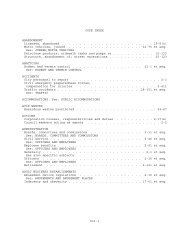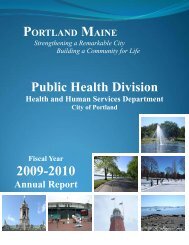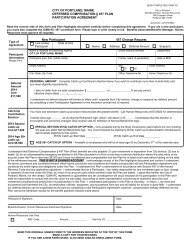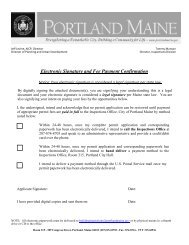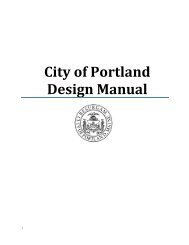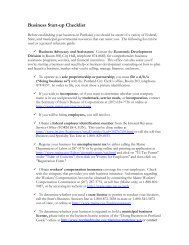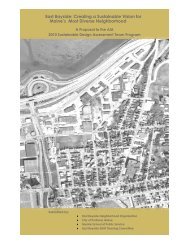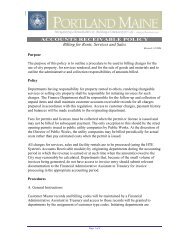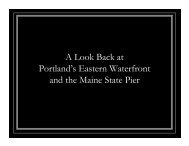City of Portland Technical Manual
City of Portland Technical Manual
City of Portland Technical Manual
You also want an ePaper? Increase the reach of your titles
YUMPU automatically turns print PDFs into web optimized ePapers that Google loves.
<strong>City</strong> <strong>of</strong> <strong>Portland</strong> <strong>Technical</strong> <strong>Manual</strong><br />
Section 5 - <strong>Portland</strong> Stormwater Management and Maine DEP Ch. 500<br />
Adopted 7/19/10.<br />
must be submitted with appropriate supporting information.<br />
(vii)Depth to the seasonal high groundwater table, depth to bedrock, and the<br />
thickness and composition <strong>of</strong> any liner used for restricting infiltration<br />
rates must be shown on the cross section view <strong>of</strong> the infiltration<br />
structure.<br />
(d) Buffers. Submit a topographic site plan showing the location <strong>of</strong> each<br />
buffer on the site, showing the layout <strong>of</strong> any berm level spreaders used to<br />
spread flows into each buffer, identifying the soil type and cover type<br />
within each buffer, and showing the land use and impervious and<br />
developed area draining to each buffer area. Provide a typical cross<br />
section for the berm level spreaders showing the geometry <strong>of</strong> the berm,<br />
the geometry <strong>of</strong> the upstream storage area, and the specifications for the<br />
berm material. Submit information demonstrating that the inslope fill<br />
material will have slopes no steeper than 3:1. Submit documentation, in<br />
the form <strong>of</strong> draft covenants and restrictions, demonstrating that buffer<br />
area(s) will be maintained as buffer.<br />
(5) Phosphorus export calculations. An application for a project using the<br />
phosphorus standards must include phosphorus export calculations.<br />
NOTE: For guidance in determining phosphorus export see "Phosphorus Control in Lake<br />
Watersheds", Maine Department <strong>of</strong> Environmental Protection.<br />
(6) Maintenance contract. Submit an executable contract with a third-party for<br />
the removal <strong>of</strong> accumulated sediments, oils, and debris within any<br />
proprietary devices and the replacement <strong>of</strong> any absorptive filters if these<br />
measures are part <strong>of</strong> a project’s proposed stormwater management system.<br />
An applicant that has the personnel and equipment necessary to perform<br />
maintenance on any proprietary devices may submit a demonstration <strong>of</strong><br />
capability in lieu <strong>of</strong> an executable contract with a third party. The frequency<br />
<strong>of</strong> sediment clean-out and filter replacements must be consistent with the<br />
unit’s storage capacity and the estimated pollutant load from the contributing<br />
drainage area. This clean-out frequency is usually established by the<br />
manufacturer <strong>of</strong> the proprietary system when sizing the device for the<br />
project. The contract must state that a qualified pr<strong>of</strong>essional will perform<br />
maintenance on stormwater management systems to maintain pollutant<br />
removal levels.<br />
E. Flooding standard submissions<br />
(1) Control <strong>of</strong> peak flows. If a project must meet the flooding standard, the<br />
project must be designed to control the peak flows from the 2-, 10- and 25-<br />
year, 24-hour storms. This is in addition to the submittal requirements listed<br />
in Section 8(C) and (D) above.<br />
165


